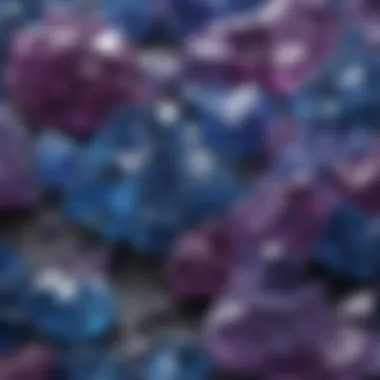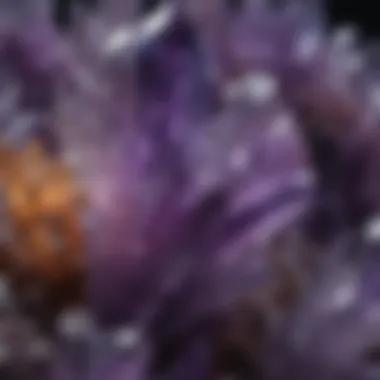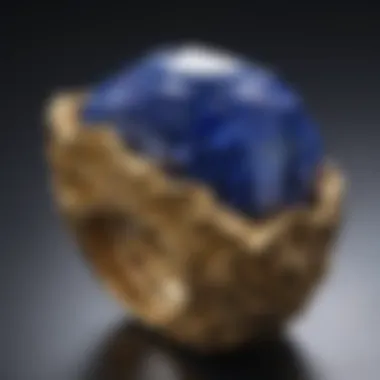Exploring the Beauty of Blue and Purple Crystals


Intro
In the world of geology, blue and purple crystals hold a distinct allure, combining both beauty and rich history. While these gemstones may captivate the eyes, their formation and characteristics provide much more than mere aesthetics. This guide seeks to elevate knowledge for both novice and expert collectors, paving the path for greater appreciation of these geological marvels.
Understanding the unique properties and cultural significance of blue and purple crystals is paramount. Enhance your personal collection by learning how to identify these stunning specimens, with their optical qualities and provenance contributing significantly to their value. Explaining the rocks hiddn behind the shimmer lends depth to the materials that adorn many homes and collections.
Rock and Fossil Identification
To fully appreciate blue and purple crystals, one must first master the art of rock identification. The simple practice of observing characteristics can distinguish a mere stone from a prized crystal. Begin by familiarizing yourself with various types of rocks and minerals, as this forms the foundation of geological knowledge.
Types of Blue and Purple Crystals
Some commonly encountered blue and purple crystals include:
- Sodalite: Typically deep blue, sometimes showing white veining.
- Iolite: Exhibits a vivid blue hue, often appearing slightly purple.
- Lapis lazuli: A deep royal blue stone often flecked with golden pyrite.
- Amethyst: A well-known purple variant of quartz.
Characteristics to Look For
Identification relies heavily on scrutinizing specific characteristics:
- Color: Observe the shade, saturation, and even intensity.
- Luster: Determine whether the crystal shines glassy or earthy.
- Transparency: Is it clear, translucent, or opaque?
- Crystal Form: Note geometric shapes inherent in each specimen.
Documentation in journals while collecting can help consolidate individual findings.
Tools for Identification
Having the right tools aids in understanding each crystal's properties:
- Loupe or Hand Lens: Enhance visibility to detect minute details.
- Field Guide: Use a reliable handbook to reference crystal specifics.
- Acid Testing Kit: Sometimes useful in identifying specific mineral content.
Collecting Tips and Techniques
==== co===lecting geologocial specimens demands bringing ideas across areas mainly ensuring collectors know the proper process.
Best Practices for Collecting
- Begin largely, selecting smaller pieces to avoid potential damage to regions with larger samples.
- Maintenance of ethical guidelines, ensuring that habitats are respected during extraction and collection.
Locating Prime Collecting Sites
Research is necessary. Some worthy places include:
- Local quarries or mines where blue or purple specimens are known to appear.
- National Parks, with geological maps offering specific clues about areas rich in such crystals.
How to Safely Extract Specimens
Employ appropriate techniques:
- Excercise care not to damage your surrounding while extracting crystals.
- Carry appropriate tools such as small chisels or hammers that offer precision over force.
Preservation and Display
After successfully gathering crystals, preserving them plays a vital role in maintaining their allure.
Techniques for Preserving Crystals
- Lightly clean specimens with warm, soapy water. Avoid strong chemicals.
- Store in individual containers or pouches to avoid scratching.
Proper Storage Methods
Categorizing specimens according to types can form an effective method in storage:
- Boxes: Use labeled compartments or trays.
- Temperature: Protect from extreme temperature fluctuations to minimize cracks.
Creative Display Ideas
Creative display ranges widely. A simple suggestion is:


- Use well-constructed shelving for optimal visibility, adding small spotlights along the glass walls.
Geological Insights
Stepping into the scientific natuer gives perspective about the wonderful formations.
Geological Formations and Processes
These crystals commonly originsare explain primarily the specific formation process. Environmental conditions, like moisture and temperature levels, greatly determine how crystals develop.
Historical Significance of Rocks and Crystals
Many cultures placed great value on these minerals:
- Consider the impact of amethyst in spiritual cabins of influence. It was seen as a protective stone.
Notable Discoveries in the Field
Throughout history, numerous blue and purple crystals have left lasting impacts through exhibitions or explorations which remind collectors of the precious beauty residing both under and above earth's crust.
Together knowledges hope-history of beauty encourages advancing not just individually collecting specimens but displaying relevance in their Crisium heirloom relevant artifacts consider geologist interesting participate entails researching relatively deeply.
Preamble to Blue and Purple Crystals
The world of blue and purple crystals presents a profound enchantment that echoes through history, science, and culture. These colorful gemstones are more than just visually striking specimens; they serve as vital links to Earth's geological processes and provide deep insights into human society's relationship with nature. Understanding these crystals is beneficial for collectors, scientists, and those intrigued by their unique attributes.
Defining Blue and Purple Crystals
Blue and purple crystals are characterized by their distinct hues, primarily stemming from the presence of specific chemical elements and structural features. For instance, the blues can often be attributed to elements like copper or iron while purple tones may result from manganese. Each type of crystal has unique mineral compositions that determine its physical properties, crystalline structure, and overall appearance.
The category of blue crystals includes varieties such as sapphire, lapis lazuli, and aquamarine, while notable purple examples encompass amethyst, purple fluorite, and sugilite. All specific minerals fall under larger classification systems in mineralogy and geology.
Importance in Geology and Collecting
Understanding blue and purple crystals is paramount not only for geologists but also for collectors. The conditions under which they form inform us about Earth's geological history, revealing the processes of mineral formation and metamorphism. Collectors appreciate these stones not only as objects of beauty but also as tokens of geological narratives.
Moreover, when collectors seek to acquire specimens, knowing the origin and quality of these crystals can impact their value greatly. For instance, authentic specimens from significant mining locations are often more valuable and sought after than lab-created or common-market varieties. Thus, an informed understanding of what constitutes “high quality” in these crystals can inform the collecting experience.
The significance of blue and purple crystals transcends mere aesthetics; they are instruments of understanding Earth’s history and cultural significance.
Exploring this realm offers a path to appreciate the details of mineralogy, the art of collection, and the emotional connection that many individuals feel towards these remarkable natural creations. This exploration promises valuable insights for everyone engaged in the world of gemstones.
Key Characteristics of Blue and Purple Crystals
Understanding the key characteristics of blue and purple crystals is essential for both collectors and enthusiasts. These specific properties can influence value, allure, and even their purported metaphysical qualities. Examining these attributes is crucial for making informed decisions about acquisition, display, and care.
Color Variations: Causes and Effects
Color in crystals like aquamarine or amethyst results from alterations in their chemical composition and environmental conditions during their formation. For example, the vibrant blue of blue sapphires comes from trace elements like iron and titanium. The intensity of a crystal’s color can vary due to these factors, impacting both its visual appeal and market value.
ul> li>strong>Environmental Influences:strong> The surrounding environment plays a role in crystal color. Temperature and pressure during their formation can lead to various hues. li>strong>Dopant Elements:strong> Presence of specific elements can modify or enhance the color. For example, chromium enhances the purple in some forms of quartz. li>strong>Color Zoning:strong> Some crystals display different colors in specific areas, a phenomenon caused by uneven distribution of minerals. ul>
Understanding these variations helps collectors assess the quality and authenticity of their specimens.
Optical Properties: Transparency and Luster
The optical properties of blue and purple crystals can significantly affect their aesthetic value. Transparency refers to how easily light passes through the crystal, while luster indicates how light interacts with its surface.
- Transparency Levels: Some crystals like blue topaz have a high degree of transparency, making them more desirable and often more valuable. In contrast, stones like purple fluorite may appear more translucent, affecting their market value and ideal uses.
- Luster Types: Crystals can have various luster types such as vitreous, resinous, or pearly. Glossy surfaces often enhance appeal. Lapis lazuli, for instance, exhibits a velvety luster.
In practical applications, understanding the optical properties allows collectors and users to assess the quality and appropriate usage of these crystals in jewelry or decor.
Physical Properties: Hardness and Cleavage
Physical properties like hardness and cleavage are paramount in both collecting and application. The Mohs scale, which classifies mineral hardness from 1 (talc) to 10 (diamond), is a measurable tool utilized by collectors.
- Hardness: Crystals with high hardness are suitable for jewelry due to their durability. For example, sapphires score a 9 on the Mohs scale. In contrast, softer crystals like amethyst, which ranks a 7, are more susceptible to scratching or damage.
- Cleavage: This property signifies how a mineral breaks along specific planes. For instance, mica has perfect cleavage, while amethyst does not. Ease of cleavage can be a factor in cutting the crystals, thus affecting overall shape and aesthetics in finished products.
It is critical for collectors to pay attention to hardness and cleavage when selecting crystals for various applications, such as jewelry making or display.


Notable Blue Crystals
Notable blue crystals gather significance not just for their visual appeal, but for their unique properties and rich histories. This section showcases three esteemed examples of blue crystals: Blue Sapphire, Lapis Lazuli, and Aquamarine. Each of these crystals has individual aspects worth exploring, enhancing the understanding of their value in geology and as collectibles.
Blue Sapphire: Formation and Value
Blue Sapphire, one of the most valued gemstones, captivates with its stunning deep blue hue. Formed in metamorphic rocks, primarily from corundum, the presence of trace elements such as iron and titanium gives the blue sapphire its color. From its formation underground, it emerges as a celebrated gem during the extraction process.
The value of Blue Sapphire lies not only in its beauty but also in its rarity. Factors such as color, clarity, cut, and carat weight play crucial roles in determining its market price. Sapphires from Sri Lanka and Kashmir are particularly prized for their vivid blues and high clarity. Furthermore, it’s believed that the origin of the sapphire can dramatically impact its valuation as well. Information on marketplace trends can be found on sites like Wikipedia or Britannica.
Lapis Lazuli: Cultural Significance
Lapis Lazuli carries a deep historical appeal that captures collectors’ interest. Its rich, intense blue, consisting mainly of lazurite, along with variations of gold from pyrite, creates an intriguing visual element. It has been used since ancient times for decorative purposes, religious artifacts, and in royal settings.
The popularity of Lapis Lazuli dates back to Mesopotamia and ancient Egypt. Pharaohs valued it as a prized stone that symbolized wealth and wisdom. Its use in jewelry was widespread, signifying its importance across various cultures. Moreover, Lapis has been deemed a stone of friendship and harmony. Its multifaceted history and connection to human culture offer ample reasons for collectors to seek it.
Aquamarine: Characteristics and Uses
Aquamarine is known for its beautiful, shimmering blue and often greenish tones, resembling tranquil waters. This crystal forms from beryl and is typically transparent, making it attractive for jewelry. The presence of iron gives this stone its distinctive hues.
Beyond aesthetics, Aquamarine has practical applications. Used in gemstones and jewelry, it is also linked to various calming properties in holistic practices. Some believe it soothes emotional health and enhances communication.
In addition to its beauty and healing properties, Aquamarine is the birthstone for March, adding sentimental value. This connection enhances its appeal for collectors and enthusiasts alike who admire more than just the physical characteristics.
Collecting notable blue crystals can enhance personal collections significantly, elevating the aesthetic value and potentially increasing financial investment in geological assets.
Notable Purple Crystals
Purple crystals do not only represent unique beauty but also hold significant importance in geology and among collectors. The depth of color in these crystals often reflects their underlying geological formation and minute details about the locality they come from. From their rarity to their varied uses in metaphysical practices, notable purple crystals serve as both collectibles and spiritual artifacts. In this section, we will explore standout examples like amethyst, purple fluorite, and sugilite, highlighting their key characteristics and considerations for collectors.
Amethyst: Myths and Lore
Amethyst is perhaps the most famous purple crystal, known for its striking violet hues. This crystal has rich lore associated with it, which includes being utilized as a protective talisman through centuries. Ancient Greeks believed that amethyst confers drunkenness to the wearer, hence its name derived from the Greek word amethystos, meaning "not drunken."
Today, amethyst is associated with clarity of mind and spiritual grounding. It is also considered helpful in feng shui practices. Collectors find value in different shades of amethysts, often seeking deeper, more saturated colors. Its availability makes it accessible, yet stunning variations still exist.
In summary:
- Highly sought due to aesthetics
- Well-documented myths and stories
- Useful in spiritual practices
Purple Fluorite: Unique Features
Purple fluorite displays stunning clarity and a wonderful spectrum, giving this mineral its unique value. Known for its fluorescent properties, purple fluorite naturally glows under ultraviolet light. This makes it a spectacular specimen for display in any collection. The crystal is composed of calcium fluoride, showcasing functionality beyond decorative appeal.
One aspect that is noteworthy with purple fluorite is its clarity. Some collectors pay premium prices for crystal formations that reflect light in intriguing ways. Moreover, purple fluorite is reported to promote concentration and prevent distractions, making it useful among scholars and practitioners of mindfulness.
Key features include:
- Fluorescence under UV light
- High clarity, varying in color intensity
- Known for boosting focus and clarity in thought
Sugilite: Symbolism and Rarity
Sugilite is not as widespread as amethyst or fluorite, rendering it rarer and highly desirable in collector circles. It is especially prized for its vibrant purple foreground sometimes marbled with black or white streaks. This beautiful gemstone is believed in various cultures to symbolize love and light.
The rarity of sugilite often contributes to its cost and value within private collections. Additionally, it is recognized for potential healing properties in metaphysical circles, said to assist with emotional struggles. The combination of its rarity and meanings give sugilite a special significance for both collectors and spiritual seekers.
Noteworthy characteristics:
- Renowned for its unique color patterns
- High demand and limited availability
- Leaf quartz connection noted in healing practices
In summary, purple crystals like amethyst, purple fluorite, and sugilite each harbor unique stories and characteristics that can greatly influence their value and appeal in personal collections.
Collecting and Caring for Crystals
Collecting crystals can be a fulfilling and enlightening hobby. Blue and purple crystals hold unique facets that attract both casual and serious collectors. Understanding how to properly select, store, and care for these precious items enhances their display and longevity. Equally important is the respect for the geological marvels they represent. A collector's responsibility encompasses authenticating the origin of the crystals and preserving their quality for future enjoyment.
Identifying Authentic Crystals
The first crucial step in collecting is identifying authentic crystals. This not only protects your investment but also ensures that the beauty and properties you seek are genuine. Techniques such as checking the light refraction can distinguish natural crystals from synthetic ones. Observing inclusions under magnification might reveal a crystal's story. Some crystals, like blue sapphire or amethyst, also have particular characteristics such as color zoning or specific crystal structures. Researching the specific qualities associated with each crystal type can equip collectors with the knowledge needed to recognize authenticity.


Storage Best Practices
Proper storage of crystals is essential to prevent damage and maintain appearance. Crystals should be stored in a dry, cool place away from direct sunlight. Clear containers or display boxes ensure visibility while protecting from dust and scratches. Use dividers to avoid friction among the crystals. For larger collections, a dedicated shelf or cabinet with adjustable space can provide organization. It is advised to handle each crystal gently to preserve its integrity. Categorizing by type or color can enhance the aesthetic of your collection.
Cleaning Techniques for Crystals
Cleaning crystals increases their beauty and extends durability. Basic cleaning can be done with a soft, damp cloth to remove dust. For more thorough cleaning, a mild soap solution is often effective. Always be cautious of using harsh chemicals as они might damage the crystal. Some crystals, like malachite or lapis lazuli, may be sensitive to water and require a different approach. For these, brushing the surface gently with a soft brush may suffice. After cleaning, a gentle pat dry should prevent moisture damage. Remember to assess each crystal for individual cleaning requirements, as they vary for each type.
A well-cared-for collection not only reflects the beauty of nature but also highlights its infinite complexity and allure. Becoming knowledgeable about your materials facilitates informed decisions involving the utmost respect for authenticity and preservation.
Proper techniques in collecting and caring for crystals ensure a rich experience both in ownership and appreciation.
The Role of Crystals in Culture and Healing
Crystals have been revered across cultures for millenia, serving not just as decorative items but also as integral components in rituals, traditions, and healing practices. Their aesthetic beauty is not the only appeal; the beliefs and claims about their metaphysical properties enhance their significance. This section will explore historical and modern perspectives on crystals in the context of culture and healing.
Historical Uses of Crystals
Throughout history, various civilizations have attributed immense value to crystals. Ancient Egyptians commonly used lapis lazuli, turquoise, and carnelian, for instance, as not only adornments but also for their believed protective qualities. Crystals were ensconced with Tomb artefacts to guide the deceased in the afterlife. Similarly, in Chinese culture, jade stones were regarded as symbols of purity and moral integrity, embedded with spiritual healing properties.
In India, crystals were associated with Vedic astrology and healing practices. Many practitioners utilized gemstones and crystals to influence chakra alignment and improve health. Their traditional practices emphasized the interplay between cosmic energy and human existence. Ancient cultures globally emphasized the healing vibrancy they felt from blue and purple crystals.
Crystals also featured in Western medicinal practices up until the middle Ages. Alchemists incorporated crystals in their experiments, believing that their energies could effect physical and spiritual transformations. As alchemy transformed into chemistry, interest in the metaphysical properties declined; but not entirely, as modern-day enthusiasts echo old beliefs passionately.
Modern Applications in Healing
In recent years, the use of blue and purple crystals has gained popularity in wellness practices. Crystals are frequently integrated into contemporary therapeutic modalities like crystal healing and Reiki. Proponents assert that the color frequencies emanated by these stones can resonate with the body’s energy systems. For example, amethyst is commonly believed to possess calming qualities, potentially aiding in stress reduction and emotional balance.
Considering scientific viewpoints, the energies associated with these crystals have not been universally validated, yet the placebo effect plays a significant role in experiences of well-being. The belief in efficacy can sometimes extend its healing impacts, therefore, creating an existential bridge in both psychological support and personal development.
On a practical level, enthusiasts employ crystals for various forms of meditation and mindfulness. By holding or placing them near during meditation, individuals aim to enhance their spiritual practice. Meanwhile, collectors appreciate not just the healing qualities but also the visual appeal and variations of their facets.
Crystals transcend materiality; they invite explorers to delve deeper into cultural perceptions and healing concepts while cherishing their physical beauty.
Global Sources of Blue and Purple Crystals
Blue and purple crystals attract many collectors and enthusiasts. Understanding where they come from enriches appreciation and adds context to their value and beauty. Knowing about their global sources provides insight into the geological processes that form these remarkable specimens. From aesthetic beauty to geological significance, the origins of these crystals warrants exploration.
Significant Mining Regions
Several regions around the world are known for their wealth in blue and purple gemstones. Some significant mining areas include:
- Kashmir, India: Famous for its exquisite blue sapphires. The Kashmiri variety is celebrated for its velvety appearance, a texture due to inclusions that enhance its allure.
- Australia: Home to some of the world’s most exceptional sapphires. The Queensland and New South Wales regions produce distinct shades of blue and effectively illustrate the popularization of natural gemstones.
- Brazil: Renowned for its aquamarine deposits, Brazil offers stunning gemstones that appeal to collectors. The clarity and vibrant color vary significantly based on the extraction region.
- Madagascar: This island is rich in multiple varieties of gemstones, notably blue sapphires and amethyst. Geologic diversity makes Madagascar a prime location for unique finds.
Visualizing the approximate mining locations on a world map can reveal patterns about accessibility and the historical context tied to the collection and trade of these crystals.
Sustainability Considerations in Mining
Krystals are not merely items to collect; they are also part of the Earth’s eco-system. Therefore, sustainability in mining is key. Here are essential consideration regarding this issue:
- Environment: Mining operations can have detrimental impacts on local ecosystems. Cutting pollution levels and restoring land post-mining should be prioritized.
- Ethical sourcing: It is vital to ensure that the gems are sourced responsibly. Many collectors encounter conflicts with stones linked to unethical or unsafe mining practices.
- Regulations: Strong regulations regarding mining practices and eco-friendly protocols are critical. Understanding the local and international laws concerning these practices can guide ethical purchasing decisions and strengthen support for conservation efforts.
Educating oneself on sustainability practices can enhance value beyond mere aesthetic appeal. Awareness translates to informed decisions when adding the striking blue and luxurious purple gems to one's collection.
Understanding the origins of your collection enriches the experience of ownership, fostering an appreciation for both beauty and the environmental impacts involved.
The End
The conclusion of this article synthesizes significant points about blue and purple crystals. Understanding these crystals extends beyond their aesthetic beauty. They represent a confluence of geological marvels and rich cultural heritage. Essentially, this overview offered nothing less than a comprehensive perspective on their importance in both personal collections and wider geological discussions.
Key highlights include their distinct characteristics, quality attributes, and geographical origins. Each crystal reflects unique traits shaped by nature's processes. Additionally, the cultural value ascribed to these minerals cannot be overstated. Knowledge of historical uses, steam from their qualities, and mythologies enwrap these crystals in deep narratives.
Moreover, considering sustainability in crystal mining speaks towards more responsible practices. Collectors can provide a voice to these values, advocating for etical collecting and supporting sustainable practices.
Recap of Key Points
- Blue and purple crystals have diverse optical and physical properties, essential in identification.
- Notable varieties like blue sapphire, amethyst, and lapis lazuli contribute to their popularity, each with distinct formation processes and historical significance.
- Collecting crystals requires a keen eye for authenticity, care practices, and understanding storage to maintain their integrity.
- Cultural contexts inform modern applications, linking ancient practices with current healing methodologies.
Encouragement for Collectors
Collecting blue and purple crystals offers not just aesthetic appeal but also educational opportunities. Each piece provides insight into geology, history, and even personal growth through healing. Collectors are encouraged to explore diverse sources and expand their collection with ethically sourced options.
Engagement with local rock and mineral clubs enhances knowledge and community connection. Resource sharing among enthusiasts attracts further exploration into lesser-known varieties. Also, preservation of these magnificent stones demands effort, making routine cleaning and appropriate storage crucial for longevity.
A journey in collecting blue and purple crystals can be enriching and immensely fulfilling. Developing a meticulous practice combined with curiosity unveils a transformative realm resplendent with geological wonders.







